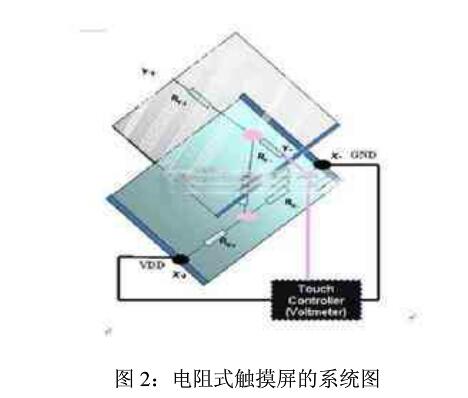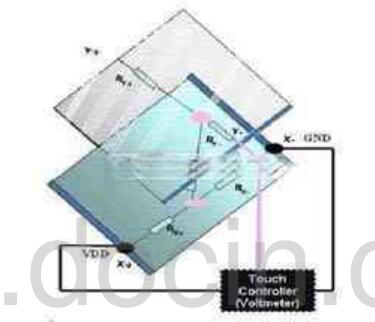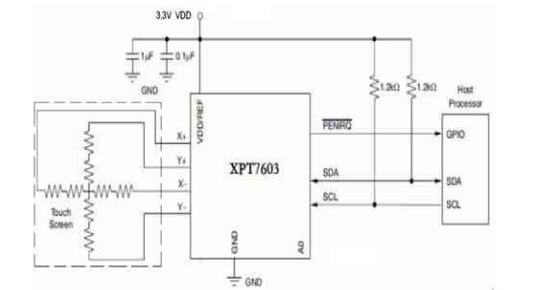This article mainly introduces the industrial touch screen control XPT7603, first introduced the principle of the industrial touch screen, followed by the principle and characteristics of the resistive touch screen, and finally introduced the working principle of the XPT7603 touch screen controller, the specific follow Xiaobian together to find out.
I. OverviewIndustrial touch screens are intelligent interfaces that connect people and machines together through touch-type industrial displays. It is an intelligent operation display terminal that replaces the traditional control buttons and indicator lights. It can be used to set parameters, display data, monitor device status, and plot automation controls in the form of curves/animations. It is more convenient, faster, more expressive, and can be simplified as a PLC control program. The powerful touch screen creates a friendly human-machine interface. As a special computer peripheral, touch screen is the most simple, convenient and natural human-computer interaction method at present. It gives multimedia a new look and is an attractive new multimedia interactive device.

The touch screen system generally includes two parts: a touch screen controller (card) and a touch detection device. Among them, the main function of the touch screen controller (card) is to receive touch information from the touch point detection device, convert it into contact coordinates, and send it to the CPU, which can simultaneously receive the command sent by the CPU and execute it: Touch Detection The device is generally installed at the front of the display, the main role is to detect the user's touch position and send it to the touch screen control card. The industrial touch screen has strong flexibility, can increase or increase the function module according to the design requirements, has strong expansibility, can meet the complicated process control process, and even can communicate directly with the network system and the PLC, which greatly facilitates the processing and transmission of control data. , Reduced maintenance.

The body part of the resistive touch screen is a multilayer composite film matched with the surface of the display, which is composed of a layer of glass or plexiglass as the base layer and a transparent conductive layer coated on the surface. The upper layer is covered with a plastic layer with a hardened, scratch-resistant outer surface. There are many small (less than one-thousandth of an inch) transparent insulation between the two conductive layers to separate them.
When the finger touches the screen, the two conductive layers that are usually insulated from each other have a contact at the touch point, because one of the conductive layers turns on the 5V uniform voltage field in the Y-axis direction, so that the voltage of the detection layer changes from zero to zero. Non-zero, this connected state is detected by the controller, A/D conversion is performed, and the Y-axis coordinate of the touch point is obtained by comparing the obtained voltage value with 5V, and the X-axis coordinate is also obtained by the same method. This is the common basic principle of all resistance technology touch screens.
The key to resistive touch screens is material technology. The resistance screen is divided into four-wire, five-wire, six-wire and multi-wire resistive touch screens according to the number of lead wires. Resistive touch screens are respectively coated with two OTI layers of transparent oxidized metal on the surface of the tempered glass. The outermost layer of OTI coating is used as a conductor, and the second layer of OTI is attached to a precise network with +5V in both horizontal and vertical directions. With a voltage field of 0V, the two OTIs are separated by small transparent isolation points. When the finger touches the screen, a touch point appears on the two OTI conductive layers. The computer detects the voltage and current at the same time and calculates the position of the touch. The response speed is 10-20 ms.
The outer conductive layer of the five-wire resistive touch screen uses a ductile nickel-gold coating material. Since the outer conductive layer is frequently touched, the purpose of using a ductile nickel-gold material is to extend the service life, but the process cost is relatively high. Although the nickel-gold conductive layer has good ductility, it can only be used as a transparent conductor and is not suitable as a working face of a resistive touch screen. Because it has a high conductivity, and the metal is not easy to achieve a very uniform thickness, it is not suitable as a voltage distribution layer. It can only be used as a probe. Floor.

Resistive touch screen is a kind of working environment completely isolated from the outside world. It is not afraid of dust and water vapor. It can be touched with any object. It can be used for writing and drawing, which is more suitable for industrial control and office use. The common disadvantage of the resistive touch screen is that because the outer layer of the composite film is made of plastic material, people who do not know how to use it or use a sharp touch may scratch the entire touch screen and cause discard. However, within the limit, scratches will only damage the outer conductive layer. Scratch of the outer conductive layer does not matter for a five-wire resistive touch screen, but it is fatal for a four-wire resistive touch screen.


The XPT7603 is a resistive touch screen controller with a 12-bit resolution AD converter. The XPT7603 can detect the pressed screen position by performing two A/D conversions. In addition, the pressure on the touch screen can also be measured. Internal comes with 2.5V reference voltage. In the typical operating state of 2.7V, turn off the reference voltage and the power consumption can be less than 0.75mW. The controller comes with an I2C interface that can operate in Slave mode with the fastest conversion rate
V. SummaryResistive touch screens have good anti-interference characteristics and application stability, and have broad application prospects in industrial production lines and even in different application environments of daily life. The touch screen will certainly play a more important role in the field of industrial control. The use of the XPT7603 as a controller can meet the requirements of strict industrial control reliability, longevity, etc., helping the industrial control of human-machine interface (HMI) touch control faster and more popular.
Our company specializes in the production and sales of all kinds of terminals, copper terminals, nose wire ears, cold pressed terminals, copper joints, but also according to customer requirements for customization and production, our raw materials are produced and sold by ourselves, we have their own raw materials processing plant, high purity T2 copper, quality and quantity, come to me to order it!
Cable Terminals
Taixing Longyi Terminals Co.,Ltd. , https://www.longyicopperterminals.com